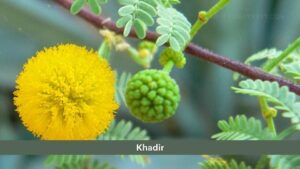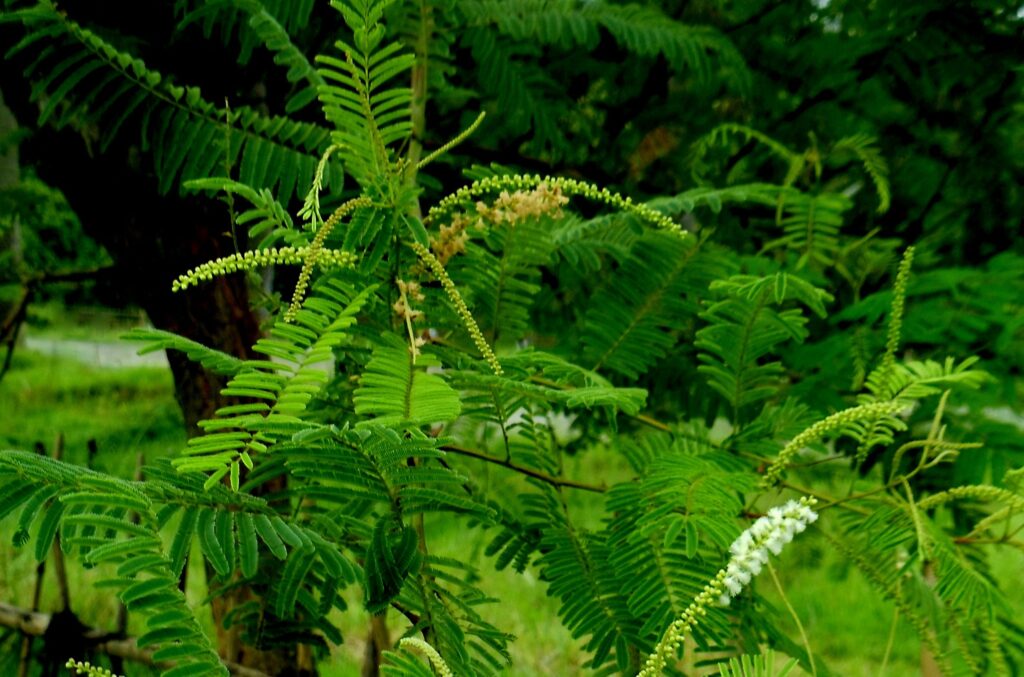Ayurvedic
Khadira (Acacia catechu) Herb Ayurvedic Overview
Khadira (Acacia catechu) is a deciduous tree, where the wood and bark of the tree are mainly valued for their medicinal purposes. The tree is commonly grown in the Himalayan and North-eastern states of India. The tree has short hooked spines and bipinnately compound leaves with 50 pairs of leaflets. The tree grows to a height of 9-12 meters, and its flowers are pale yellow with cylindrical spikes bearing fruits that are flat and oblong pods. The lumps are dark brown from the outside and red from the inside.
Khadira is loaded with anti-inflammatory, antioxidant, antimicrobial compounds. The bark of the khadira tree is dark brown to grayish which splits into longitudinal sections. It is widely used for skin problems like eczema, psoriasis, and the management of blood disorders. The bark, gum, heartwood of Acacia catechu is used in various Ayurvedic preparations for a very long time. Khadira is widely utilized for the management of various diseases like boils, diarrhea, worm infestations, fever, asthma, cough, bronchitis, and also in oral disorders like stomatitis, mouth ulcers, gingivitis, etc.
The crushed bark of acacia catechu is used topical on wounds as it is a very potent wound healing medicinal plant. Also, it exhibits antimicrobial properties which prevent the growth of microbes on wounds. This property is due to the presence of flavonoids, tannins, and other active ingredients. Its anti-obesity properties help in shedding extra kilos by triggering the metabolism.
Scientific Classification of Khadira (Acacia catechu):
- Kingdom: Plantae
- Phylum: Spermatophyta
- Subphylum: Angiospermae
- Class: Dicotyledonae
- Order: Fabales
- Family: Fabaceae
- Subfamily: Mimosoideae
- Genus: Acacia
- Species: Acacia catechu
Khadira (Acacia catechu) Synonyms:
- Sanskrit: Gayatri
- Assamese: Kharira, Khara, Khayar
- Bengali: Khera, Khayera
- English: Black catechu, Cutch tree.
- Gujrati: Khair, Kathe, Kher
- Hindi: Khair
- Kannada: Kaggali, Kaggalinara, Kachinamara, Koggigida
- Kashmiri: Kath
- Malayalam: Karingali
- Marathi: Khaira, Khair
- Oriya: Khaira
- Punjabi: Khair
- Tamil: Karungali, Karungkali
- Telugu: Chandra, Kaviri
- Urdu: Chanbe Kaath
Khadira (Acacia catechu) Description:
 a) Macroscopic: Acacia catechu is a heart-wood, light red, turning brownish-red to nearly black with age, attached with whitish sapwood, fracture hard, taste, astringent.
a) Macroscopic: Acacia catechu is a heart-wood, light red, turning brownish-red to nearly black with age, attached with whitish sapwood, fracture hard, taste, astringent.
b) Microscopic: The transverse section of the heart-wood shows medullary rays. The vessels occurring isolated or in small groups. The xylem fibers with narrow lumen occupying a major portion of wood, and the xylem parenchyma usually predominantly paratracheal, forming a sheath around vessels. The wood of Khadira consists of crystal fibers with 14-28 segments, each having one prismatic crystal of calcium oxalate. Some of the cells, including vessels, filled with brown content, prismatic crystals of calcium oxalate present in several cells throughout the wood.
Identity, Purity, and Strength of Khadira (Acacia catechu):
- Foreign matter Not more than 2 percent, Appendix 2.2.
- Total Ash Not more than 2 percent, Appendix 2.3.
- Acid-insoluble ash Not more than 1.2 percent, Appendix 2.4.
- Alcohol-soluble extractive Not less than 1 percent, Appendix 2.6.
- Water-soluble extractive Not less than 3 percent, Appendix 2.7.
Chemical Constituents of Khadira (Acacia catechu):
The heartwood of the Khadira tree is consists of catechin and catechutanic acid. The wood is rich in α- β-, γ- Catechin, i- epicatechin, (+) – Afzelchin, gossypetin, procyanidin Ac and Taxifolin and the gum is rich in L- arabinose, D- galactose, , D- rhamnose.
Ayurvedic Properties and Action of Khadira (Acacia catechu):
- Rasa: Tikta, Kshaya
- Guna: Laghu, Ruksha
- Virya: Shita
- Vipaka: Katu
- Doshagnatha: Kapha-Pittahara
- Karma: Raktashodhak, Kaphapittahara, Kushtaghana, Krimighana, Medohara.
Ayurvedic Formulation made by Khadira (Acacia catechu):
The most common composition of Khadira are Khadiradi vati, Khadirarishtam, Khadiradi gutika, Khadiradi kashaya, Mahamanjishthadi Kwath, Dashmoolarishtam.
Therapeutic Uses of Khadira (Acacia catechu):
The therapeutic uses are Kasaghana, Dantya, Kandughana, Medoghana, Jwaraghan, Shothahara, Amahara, Panduhara, Kushtahara, Vranaropana, Mutra sangrahaniya, Stambana, Ruchikara.
Dose of Khadira (Acacia catechu):
20-30 gm of the drug for the decoction.
Reference:
Ayurvedic Pharmacopeia of India.
For regular health updates, Please follow our Social Pages


